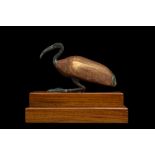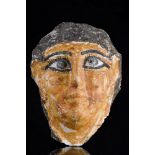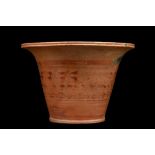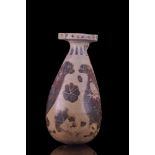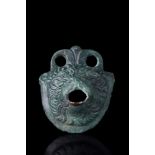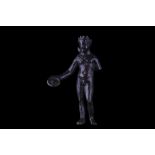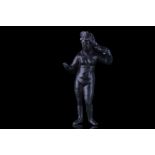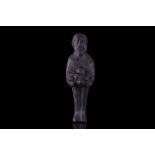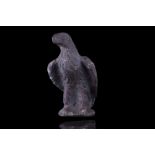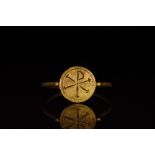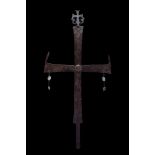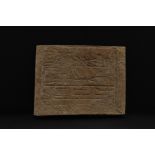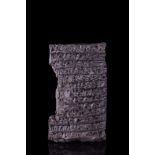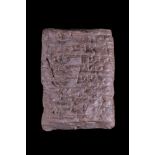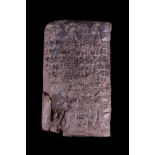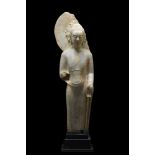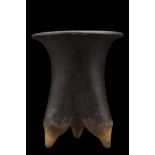Verfeinern Sie Ihre Suche
Sortieren nach:
- Kategorie
- Liste
- Galerie
Ein Abonnement der Preisliste ist notwendig um Ergebnisse, von Auktionen die vor einem längeren Zeitraum als 10 Tagen stattgefunden haben, ansehen zu können. Klicken Sie hier für mehr Informationen
Late Period to Ptolemaic Period, Ca. 664-32 BC. An ancient Egyptian gilt wood and bronze Ibis depicted seated, the body sculpted in wood, covered ...
Roman Period, Ca. 100 AD. Lovely face mask of plaster or stucco over linen; with handsome features painted in yellow and reddish pigments, the eye...
Ca. 100-200 AD. A large marble cupid statue carved in the round. Cupid is depicted nude and fleshy, standing and motion to the right, with his rig...
Ca. 200-300 AD. A pair of beautiful, life-size marble statues of nude children representing Harpocrates, the god of silence and secrecy, each repr...
Ca. 100 AD. A bronze statuette of Jupiter depicting Zeus Brontaios, the Thunderer, modelled in the round after a statuette by Greek sculptor Leoch...
Ca. 100-300 AD. An outstanding pair of bronze and iron fittings, each one comprising a spiral fluted column with an iron rod projecting from the I...
Ca. 100-300 AD. A pair of bronze chariot appliqués, each with a bust formed separately and mounted at the centre, each comprising a discoid body w...
Ca. 600-500 BC. A terracotta protome depicting a lovely visage of a goddess with well-modeled facial features wearing a decorative headdress. A pr...
Ca. 300-1 BC. A substantial ceramic bull's head from a rhyton with naturalistic features; modelled with short horns, ears, frowning face, eyes, sn...
Ca. 300 BC. A terracotta Messapian Kalathos, the body decorated in with two bands of red painted wreaths, in between two red painted bands. Very f...
Ca. 600 BC. A beautiful pottery alabastron with a piriform body with a flat disk rim connected by a small loop with a neck. The exterior is adorne...
Ca. 1st–2nd century AD. A superbly cast lion protome with the rich full mane of overlapping wavy locks, the lion's mouth open wide, the muzzle nat...
Ca. 100-300 AD. A bronze figurine of a young Eros, depicted in a standing pose, naked. He is striding forward with his left leg advanced, his righ...
ROMAN BRONZE VENUS FIGURINE
Ca. 1-200 AD. A cast bronze statuette of goddess Venus standing with her weight on her right leg, the left leg bent at the knee and slightly advan...
ROMAN BRONZE PRIAPUS FIGURE
Ca. 100-300 AD. A free-standing bronze statuette of the god Priapus shown with a long beard, standing with erect phallus and a pile of fruit, symb...
ROMAN BRONZE EAGLE FIGURINE
Ca. 100 AD. A realistically modelled bronze eagle figurine, standing on a base, long wings folded, the wingtips crossed, feather detailing to the ...
ROMAN GLASS UNGUENTARIUM
Ca. 1st-3rd century AD. An amphora shaped vessel with an ovoid body with a strand of glass pulled out at the bottom to form a tip and a tall tubul...
Ca. 300-400 AD. An elegant gold hoop with an attached circular plate bezel flanked by spherical baubles. The bezel features an incised Chi-Rho mot...
Ca. 1100-1400 AD. An exquisite cast copper-iron processional cross composed of two flared sections pinned together in the center with a cast-bronz...
Ca. 1100-1400 AD. A silver ring with D-shaped hoop and circular bezel featuring an elaboarate gold inlaid cross. The Cross, the principal symbol o...
Ca. 800-1000 AD. A reliquary cross pendant cast in two separate pieces and hinged at the top and bottom. Both faces are engraved with a standing a...
Ca. 800-1000 AD. A cast-bronze reliquary cross pendant composed of two cruciform plaques that fit together, a hinged mechanism to the top and bott...
Ca. 800-1000 AD. A cast-bronze reliquary cross pendant composed of two cruciform plaques that fit together, a hinged mechanism to the top and bott...
Ca. 800-1000 AD. A finely modelled reliquary cross composed of two cruciform plaques that fit together, a large loop for suspension, and a hinged ...
Ca. 800 AD. A bronze cruciform pendant in the form of a Latin cross decorated with a depiction of Jesus between busts of saints to each arm. The C...
MEDIEVAL BRONZE CROSS PENDANT
Ca. 1100-1300 AD. A bronze cruciform pendant with scalloped arms and an integral circular suspension loop. The obverse is embellished with an inci...
Viking Age, Ca. 900-1100 AD. A bronze cross pendant comprising four flat arms decorated with concentric circles representing Sun motifs. Good cond...
MEDIEVAL BRONZE CROSS PENDANT
Ca. 1100-1300 AD. A bronze pendant in the form of a cross with a rounded suspension loop at the top. The front bears a moulded relief of a cross. ...
MEDIEVAL BRONZE RING WITH CROSS
Crusaders Period, Ca. 1100-1400 AD. A solid bronze ring comprising a circular band, shield-shaped shoulders linearly decorated, and a large round ...
Ca. 300 BC. A funerary stele, polygonal in form, sculpted in low relief with a face head with almond-shaped eyes, a prominent long triangular nose...
Ca. 200-300 AD. A grey schist carving of a standing Buddha. This excellent figure is backed by a circular halo and dressed in a flowing Kasaya (mo...
Ca. 100-300 AD. A schist stone head of a Buddha. He is depicted with wavey hair gathered up in a topknot above a headband. His face characteristic...
Ca. 300 BC. An alabaster funerary stele sculpted in high relief with a male head with eyes, recessed for inlays, prominent eyebrows merging into a...
SUMERIAN HUMBABA POTTERY MASK
Ca. 3500 BC. A pottery grotesque head with a prominent nose and grimacing mouth, depicting Humbaba. In Sumerian and Akkadian mythology, Humbaba wa...
HOLY LAND CREAM BUFF BOWL
Middle Bronze IIB-C, Ca. 1730-1550 BC. A finely sculpted, pottery bowl in cream buff with a carinated shoulder from which the walls of the body ta...
SUMERIAN CLAY CUNEIFORM TABLET
Ca. 2100-2000 BC. A rectangular clay tablet with columns of cuneiform text. Clay cuneiform tablets were small enough to be portable and durable wh...
BABYLONIAN CLAY CUNEIFORM TABLET
Ca. 1900 BC. A rectangular-shaped clay tablet, written in cuneiform. The inscriptions on the tablet refer to administrative and legal affairs. Cun...
BABYLONIAN CLAY CUNEIFORM TABLET
Ca. 1900-1600 BC. A rectangular-shaped clay tablet, written in cuneiform. The inscriptions on the tablet refer to administrative and legal affairs...
BABYLONIAN CLAY CUNEIFORM TABLET
Ca. 1900-1800 BC. A roughly rectangular-section ceramic tablet, bearing cuneiform script to both faces. Documents such as they were used or a mult...
Northern Qi Dynasty, Ca. 550-577 AD (or later). The slender, elegant figure is depicted in a standing pose, originally on top of a socle, with rig...
Xiajiadian Culture, Ca. 2300-1600 BC. A tall pottery vessel with a wide everted rim above an elongated body, raised upon three conical legs, resem...

